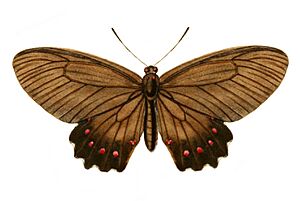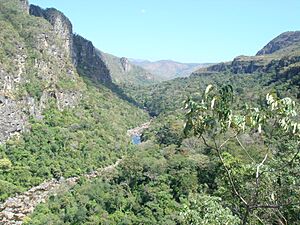Parides burchellanus facts for kids
Quick facts for kids Parides burchellanus |
|
|---|---|
 |
|
| Conservation status | |
| Scientific classification | |
| Synonyms | |
|
Parides panthonus jaguarae (Foetterle, 1902: male) |
The Parides burchellanus is a beautiful butterfly from the swallowtail butterfly family. It is a special kind of butterfly because it is found only in Brazil.
Contents
What Does It Look Like?
The Parides burchellanus is a large butterfly with a soft, velvet-black color. Its front wings are mostly plain, except for small white spots along the edges. If you look at the underside of its back wings, you'll see small red spots near the outer edges. These spots are usually lighter and smaller on the bottom side of the wing.
The edges of its back wings are wavy, like scallops. Male butterflies have a special small pouch on the edge of their back wing. This butterfly does not have tails, which many other swallowtail butterflies do. Besides this pouch, male and female Parides burchellanus butterflies look very much alike.
Life Cycle and Food
The young butterflies, called caterpillars, eat specific plants. Their favorite food plants are Aristolochia chamissonia and A. melastoma. These plants are very important for the caterpillars to grow and change into butterflies.
Butterfly Family Tree
The Parides burchellanus is part of a group of butterflies called the Parides aeneas group. These butterflies are all very similar to each other. Some scientists even think that Parides burchellanus might be the same species as Parides aeneas.
Other butterflies in this group include:
- Parides aeneas
- Parides aglaope
- Parides burchellanus
- Parides echemon
- Parides eurimedes
- Parides lysander
- Parides neophilus
- Parides orellana
- Parides panthonus
- Parides tros
- Parides zacynthus
Where It Lives and Why It's in Danger
This butterfly is very rare. It lives in only a few special places in central Brazil. It prefers to live in forests along rivers that flow through the cerrado landscape. These are called gallery forests or riparian forests.
The Parides burchellanus needs these specific environments to survive. It often lives near narrow streams where the trees form a canopy over the water.
Sadly, its home is very fragile. As more natural areas are cleared for other uses, the places where this butterfly can live are shrinking. This makes the Parides burchellanus very vulnerable and at risk of disappearing.

Naming the Butterfly
The butterfly was named after a person named William John Burchell.




